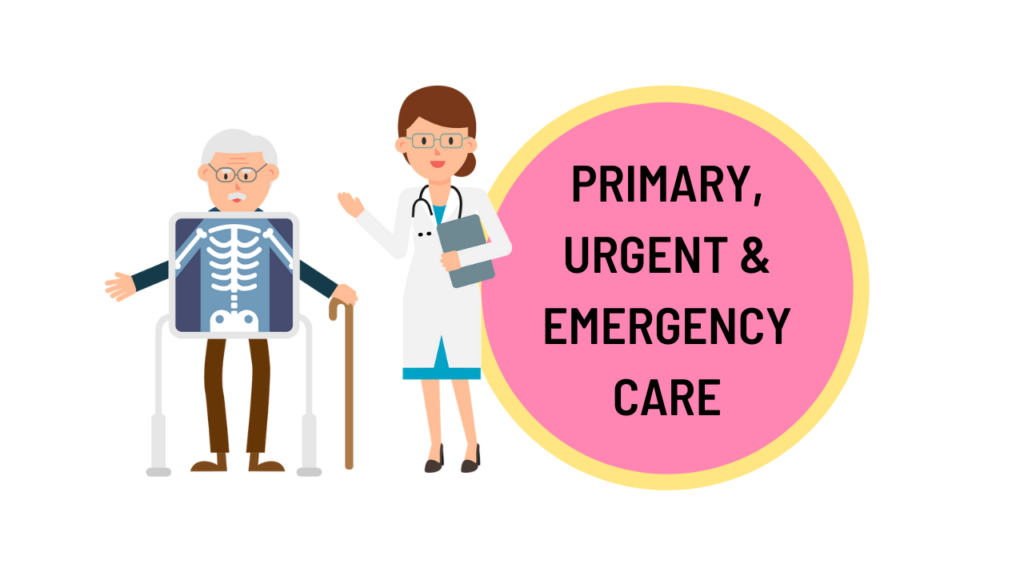
To receive the best medical care for your unique situation, you’ll need to know how Primary Care, Urgent Care & Emergency Care differ. That way, you’ll be certain of which clinic type to call first (and which ones won’t cost you an arm and a leg!)
In this article, I’ll be answering any questions you may have about these three types of clinics so you’ll know exactly which option is the best for your situation.
Table of Contents
Primary Care Explained
Let’s start with primary care, since this tends to be the most familiar out of the three for people. A primary care practitioner/physician, or PCP, is your go-to doctor for general health maintenance. Their job is not only to treat patients but also emphasize prevention and provide diet and exercise counseling.
A primary care practitioner is the one doctor you should establish care with if none other, and you should see your PCP at least once a year for general health maintenance. If you have a chronic condition–like diabetes, for example–you’ll need to see your PCP more frequently.
With that in mind, here’s a short list of things that you should see your PCP for:
- Annual physical exam w/ labs
- Management of chronic conditions (e.g. diabetes, high blood pressure, high cholesterol)
- Treatment for mild or moderate acute conditions (e.g. flu-like symptoms, infections, rash)
- Vaccinations
- Referrals*
*With many clinics utilizing telehealth and EMR (electronic medical record), most patients are able to request a referral through their patient portal online and skip a whole visit. When calling in or sending your message to your PCP, just remember to state which department you’re looking to get referred to and why.
PCPs are trained in a broad range of medical conditions so they should be your first point of contact when it comes to non-emergency medical issues.
Bonus information (PCPs vs. specialists): To paint a better picture, PCPs can be contrasted with specialists (e.g. cardiologist, dermatologist, orthopedic surgeon).
While PCPs are trained to understand a wide range of medical conditions that span numerous specialties, specialists focus instead on a single branch of medicine and study it at a very high level.
Below is a visual representation with endocrinologists being the example specialist:
*The expertise level values are used to show relatively. The values themselves do not stand for any real-life method of measurement.
This goes to show why some patients can be managed by PCPs, whereas others need to see a specialist. If a particular patient has high blood pressure but no other known heart conditions nor relevant family history, then he/she can be managed by primary care. However, if a patient has high blood pressure, high cholesterol, arrhythmia, and a strong family history of heart disease, for example, then he/she should seek out a cardiologist.
Types of PCPs (Primary Care Practitioners)
Now that we’ve established what PCPs are and what they do, let’s talk about the different types of PCPs. “Primary care practitioner” is actually a big umbrella term that includes four main subcategories of physicians. Depending on your circumstances and lifestyle, you’ll want to pick the one best suited for your needs. Here, I’ll give you a quick rundown of each and some of the differences between them.
There are 4 types of primary care physicians:
- Internist
- Family physician
- Pediatrician
- Geriatrician
Internist
An internist is a PCP that only takes adults as patients. (Sorry for those of you under 18 years old.) Their job is to diagnose and treat you, as well as educate you on health maintenance and disease prevention. Some issues you’ll want to see an internist for include – but are not limited to – annual checkup and blood draw, management of chronic conditions (e.g. asthma, arthritis), and common acute illnesses like a sore throat.
Family Physician
Unlike an internist, a family physician (FP) sees patients of all ages: children, adolescents, adults, and elderly. Oftentimes, one FP will see multiple members of the same family, which can be very convenient. They’re a good choice for families (hence, the name), especially if certain conditions or diseases are known to run in a particular family. Family physicians’ area of expertise is similar to that of internists, with preventative medicine being the focus.
Pediatrician
A pediatrician is a doctor who specifically sees infants, children, teenagers, and young adults. Typically, patients make the switch to either an internist or family physician between ages 18 and 21. This is where you’ll want to think about what the best option is for you. It may be much easier to have a family physician who you can see no matter your age. However, others may prefer to start with a pediatrician and then switch to an internist, as these two are slightly more specialized in each of their respective fields.
Geriatrician
Last but not least is geriatricians. Geriatricians specialize in treating older patients, typically age 65 and older. These physicians have extra training in treating conditions that tend to affect older populations (e.g. impairment, dementia, osteoporosis, multiple and/or complex medical issues.), which makes them an excellent option, especially for elderly individuals who have conditions that require more attention and stricter management.
Urgent Care Explained
Now that we’ve covered primary care, let’s move on to urgent care. You’ve probably heard of urgent care before but may not be too familiar with it. It sounds similar to emergency care, yet you’ve never heard of an ambulance taking someone to urgent care.
Simply put, urgent care is somewhere in between primary and emergency care. Unlike primary care, urgent care centers are based on walk-ins, rather than scheduled appointments. This means you may have to wait some time, depending on how busy the clinic is, but you’re guaranteed to be seen by a medical professional that day.
Tips for Urgent Care Appointments
Personally, the longest that I’ve waited to be seen at an urgent care clinic is 45 minutes. The best course of action is to show up early so you have a spot secured. Another thing you can do is call different urgent care clinics in your area and ask how long their wait times are. Keep in mind that while it is possible to have to wait a few hours, wait times are often shorter than projected.
When Should I Go to Urgent Care Instead of Primary Care?
Sometimes, PCPs are booked out for weeks or even months at a time. This is when urgent care is a great option. If you’re dealing with a non-life-threatening medical issue that requires a more timely appointment, urgent care is your best bet.
Here’s a short list of things that you can go to urgent care for:
- Flu-like symptoms (e.g. fever, sore throat, cough)
- Abdominal pain
- Minor cuts or burns
- Urinary tract infections
- Sprains
Benefits of Urgent Care
Another perk of urgent care is that it’s usually a less expensive option than going to the emergency room. Many insurance plans will charge you a similar amount to what you would pay for a PCP visit. Check with your plan to see what’s covered so you have a better idea of what to expect in the event that you may need to go to urgent care.
Warning: Some clinics may bill urgent care visits as emergency room (ER) visits, which is significantly more expensive than a primary care visit. To be on the safe side, double check by calling your insurance AND the urgent care clinic before going.
Overall, urgent care can be a great option. It definitely would’ve saved me a large medical bill when I was younger, since there was one time I ended up having to go to the ER for stomach pain since my primary care office was closed that day.
Not only does urgent care allow you to be seen by a medical professional in a timely manner and at a much lower cost, but it also allows the ER to deliver better care, since those left in the ER will be true emergency cases. This might not seem like a big deal to you now, but those who have been subjected to long wait times in the ER would greatly appreciate it.
Reminder: If it’s your first time going to urgent care, make sure to bring your ID and insurance card.
Emergency Care Explained
The final category we’ll be discussing in this article is emergency care. This is for–as the name states–emergencies. If you think you may be having a heart attack or stroke, or if you’ve experienced severe physical trauma (motor vehicle accident, concussion, laceration, etc.), you should go directly to the ER, where they have the most tools and resources to best treat you in a timely manner.
When Should I Go to Urgent Care Instead of Emergency Care?
Now you may be wondering what differentiates when you should go to urgent care versus the emergency room. This depends on how severe your case is. If your condition is not life-threatening but requires more timely attention, then you should go to urgent care. However, if the issue at hand is serious or potentially life-threatening, then you should go to the emergency room.
Here are some conditions for which you should head straight to the ER and NOT Urgent Care:
- Chest pain
- Difficulty breathing
- Heart attack or stroke
- Severe allergic reaction
- Deep wound
- Severe burn
- Broken bone(s)
- Head injury
- Seizure(s)
To review, I’ve listed the signs and symptoms of a heart attack and stroke below so you can be better prepared at spotting them in yourself and others, since they are two leading causes of death and disability in the US.
Signs of a Heart Attack
(Yes, heart attack symptoms show up differently in males and females and tend to be much easier to identify in males, fortunately or unfortunately.)
| In Males | In Females |
|---|---|
| Chest pain | Chest pressure |
| Shortness of breath | Pain between the shoulders |
| Sweating | Lightheadedness or dizziness |
| Nausea | Indigestion |
| Heartburn or indigestion | Fatigue |
Signs of a Stroke
The acronym for identifying signs of a stroke is “BE FAST.” Here’s what each letter stands for:
- B (balance): Loss of balance
- E (eyes): Loss of vision in one or both eyes
- F (face): Facial droop or asymmetrical face
- A (arm): Weakness or numbness in one arm
- S (speech): Slurred and/or confused speech
- T (time): Call 9-1-1 immediately!
Bonus information (Knowing your rights): Hospitals are required by law to treat patients having a medical emergency, regardless of the patient’s insurance status or ability to pay.
Conclusion
Now, you have a better idea of your options and ways to maximize your care. I hope that you found this information helpful, as navigating the healthcare system can be extremely challenging and confusing. I definitely had a lot of fun writing this article – good luck and see you again soon! 🙂
